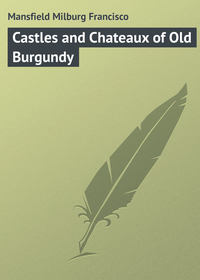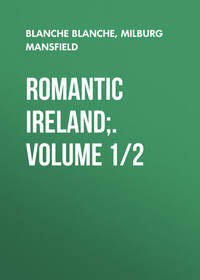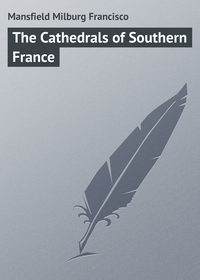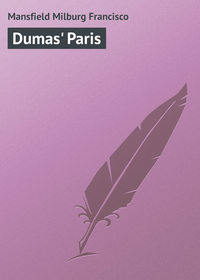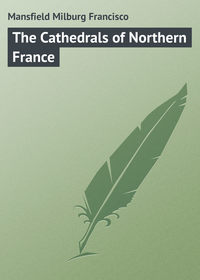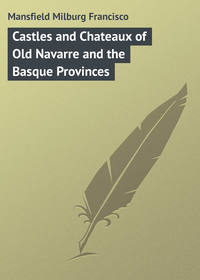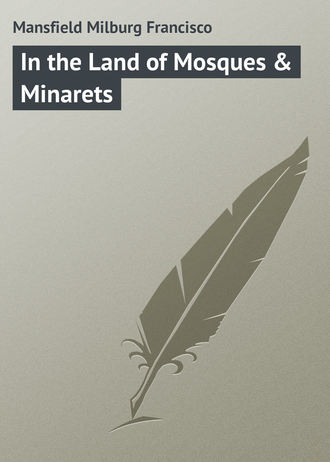 полная версия
полная версияIn the Land of Mosques & Minarets
There is no more danger to the tourist travelling through Algeria and Tunisia by road than there would be in France or Italy – and considerably less than might be met with in Spain. There are some brigands and robbers left hiding in the mountains, perhaps, but their raids are on flocks and herds, and not for the mere dross of the gold of tourists, or the gasolene of automobilists. The desert lion is a myth of Tartarinesque poets and artists, and one is not likely to meet anything more savage than a rabbit or a hedgehog all the fifteen hundred or two thousand kilometres from Tlemcen to Gabès.
The African lion is a dweller only in the forest-grown mountains; and the popular belief that it can track for weeks across the desert, drinking only air, and eating only sand, is pure folly of the romantic brand perpetuated by the painter Gérome.
During the last ten years, in all Algeria there were killed only: —
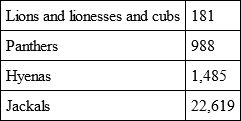
It may be taken for granted, then, that there are no great dangers to be experienced on the well-worn roads and pistes of Tunisia and Algeria. The hyenas and lions are hidden away in the great mountain fastnesses, and the jackals themselves are harmless enough so far as human beings are concerned. The sanglier, or wild boar, is savage enough if attacked when met with, otherwise it is he who flees, whilst the jack-rabbits and the gazelles make up the majority of the “savage life” seen contiguous to the main travelled roads away from the railways.
Scorpions and horned vipers are everywhere – if one looks for them, otherwise one scarcely ever sees one or the other. The greatest enemy of mankind hereabouts is the flea; and, as the remedy is an obvious and personal one, no more need be said. Another plague is the cricket, grasshopper or sauterelle. The sauterelle, says the Arab, is the wonder among nature’s living things. It has the face of a horse, the eyes of an elephant, the neck of a bull, the horns of a deer, the breast of a lion, the stomach of a scorpion, the legs of an ostrich, the tail of a snake, and is more to be feared than any of the before enumerated menagerie. It all but devastated the chief wheat-growing lands of the plateaux of the provinces of Alger and Constantine a generation or more ago, and brought great misery in its wake.
The scorpion and the gazelle are the two chief novelties among living things (after the camel) with which the stranger makes acquaintance here. The former is unlovely but not dangerous. “Il pique, mais ne mord pas,” say the French; but no one likes to find them in his shoes in the morning all the same. The gazelle is more likable, a gentle, endearing creature, with great liquid eyes, such as poets attribute to their most lovely feminine creations.
The gazelle is an attribute of all fountain courtyards. It lives and thrives in captivity, can be tamed to follow you like a dog, and is as affectionate as a caressing kitten. It will eat condensed milk, dates, cabbage and cigarettes; but it balks at Pear’s soap.
In the open country the nomad Arab or even the house-dweller that one meets by the roadside is an agreeable, willing person, and when he understands French (as he frequently does), he is quite as “useful” as would be his European prototype under similar conditions. The country Arab is courteous, for courtesy’s sake, moreover, and not for profit. This is not apt to be the case in the cities and towns.
The Arab speech of the ports and railway cities and towns is of the solicitous kind. One can’t learn anything here of phraseology that will be useful to him in the least and it’s bad French. “Sidi mousi! Moi porter! Moi forsa besef!” is nothing at all, though it is eloquent, and probably means that the gamin, old or young, wants to carry your baggage or call a cab. And for this you pay in Algiers and Tunis as you pay in London or Paris, but you are not blackmailed as you are in Alexandria or Cairo.
One may not rest two minutes on the terrace of any café in a large Algerian town without having an Arab, a Kabyle, or a Jewish ragamuffin come up and bawl at one incessantly, “Ciri, ciri, ciri!” If you have just left your hotel, your boots brilliant as jet from the best Algerian substitute for “Day & Martin’s Best,” it doesn’t matter in the least; they still cry, “Ciri, ciri, ciri, m’siou!” Sometimes it is, “Ciri bien, m’siou!” and sometimes “Ciri, kif, kif la glace de Paris!” But the object of their plaint is always the same. Finally, if you won’t let them dull the polish of your shine, they will cire their faces and demand “quat’ sous” from you because you witnessed the operation. Very businesslike are the shoeblacks of Algiers; they don’t mind what they cire as long as they cire something.
The Café d’Apollon in Algiers is the rendezvous of the “high-life Arab.” Here Sheiks from the deserts’ great tents, Caïds from the settlements, and others of the vast army of great and small Arab officialdom assemble to take an afternoon bock or apéritif; for in spite of his religion the Mussulman will sometimes drink beer and white wine. Some, too, are “decorated,” and some wear even the ruban or bouton of the Legion of Honour on their chests where that otherwise useless buttonhole of the coat of civilization would be. Grim, taciturn figures are these, whose only exclamation is a mechanical clacking of the lips or a cynical, gurgling chuckle coming from deep down, expressive of much or little, according as much or little is meant.
The foreign population in Algeria and Tunisia is very mixed; and though all nationalities mingle in trade the foreigners will not become naturalized to any great extent. Out of forty-one naturalized foreigners in Tunis in 1891, 27 were Italians, 2 Alsatians, 2 Luxembourgeois, 2 Maltese, 1 German, 1 Belgian, 1 Moroccan, and 5 individuals of undetermined nationality.
Civilization and progress has marked North Africa for exploitation, but it will never overturn Mohammedanism. The trail of Islam is a long one and plainly marked. From the Moghreb to the Levant and beyond extends the memory and tradition of Moorish civilization of days long gone by. The field is unlimited, and ranges from the Giralda of Andalusia to the Ottoman mosques of the Dardanelles, though we may regret, with all the Arab poets and historians, the decadence of Granada more than all else. The Arab-Moorish overrunning of North Africa defined an epoch full of the incident of romance, whatever may have been the cruelties of the barbarians. This period endured until finally the sombre cities of the corsairs became the commercial capitals of to-day, just as glorious Carthage became a residential suburb of Tunis. The hand of time has left its mark plainly imprinted on all Mediterranean Africa, and not even the desire for up-to-dateness on the part of its exploiters will ever efface these memories, nor further desecrate the monuments which still remain.
The French African possessions include more than a third of the continent, an area considerably more extensive than the United States, Alaska, Porto Rico, and the Philippines combined. One hears a lot about the development of the British sphere of influence in Africa; but not much concerning that of the French which, since the unhappy affair of Fashoda, has been more active than ever. The French are not the garrulous nation one sometimes thinks them. They have a way of doing things, and saying nothing, which is often fraught with surprises for the outside world. Perhaps Morocco and Tripoli de Barbarie may come into the fold some day; and, then, with the French holding the railways of Egypt and the Suez Canal, as at present, they will certainly be the dominant Mediterranean and African power, if they may not be reckoned so already.
The Saharan desert is French down to its last grain of sand and the last oasis palm-tree, and it alone has an area half the size of the United States.
Of Mediterranean French Africa, Tunisia is a protectorate, but almost as absolutely governed by the French as if it were a part of the Ile de France. Algérie is a part of France, a Department across the seas like Corse. It holds its own elections and has three senators and six deputies at Paris. Its governor-general is a Frenchman (usually promoted from the Préfecture of some mainland Département) and most of the officialdom and bureaucracy are French.
Trade between Algeria and France, mostly in wines and food stuffs on one side, and manufactured products on the other, approximates three hundred millions of francs in each direction. Algeria, “la belle Algérie” as the French fondly call it, is not a mere strip of mountain land and desert. It is one of the richest agricultural lands on earth, running eastward from the Moroccan frontier well over into Tunisia; and, for ages, it has been known as the granary of Europe. The Carthaginians and the Phœnicians built colonies and empires here, and Rome was nourished from its wheat-fields and olive-groves.
The wheat of Africa was revered by the Romans of the capital above all others. One of the pro-consuls sent Augustus a little packet of four hundred grains, all grown from one sole seed, whereupon great national granaries were built and the commerce in the wheat of Africa took on forthwith almost the complexion of a monopoly. The sowing and the harvest were most primitive. “I have seen,” wrote Pliny (H. N. XVIII, 21), “the sowing and the reaping accomplished here by the aid of a primitive plough, an old woman and a tiny donkey.” The visitor may see the same to-day!
At the moment of the first autumn rains the Arab or Berber cultivator works over his soil, or sets his wives on the job, and sows his winter wheat. The planting finished, the small Arab farmer seeks the sunny side of a wall and basks there, watching things grow, smoking much tobacco and drinking much coffee, each of these narcotics very black and strong. Four months later his ample, or meagre, crop comes by chance. Then he flays it, not by means of a flail swung by hand, but by borrowing a little donkey from some neighbour, – if he hasn’t one of his own, – and letting the donkey’s hoofs trample it out. Now he takes it – or most likely sends it – to market, and his year’s work is done. He rolls over to the shady side of his gourbi (the sunny side is getting too warm) and loafs along until another autumn. He might grow maize in the interval, but he doesn’t.
The Barbary fig, or prickly-pear cactus, is everywhere in Algeria and Tunisia. It grows wild by the roadside, in great fields, and as a barrier transplanted to the top of the universal mud walls. Frost is its only enemy. Everything and everybody else flees before it except the native who eats its spiny, juicy bulbs and finds them good. The rest of us only find the spines, and throw the fruit away in disgust when we attempt to taste it. The Barbary fig is the Arab’s sole food supply when crops fail, the only thing which stands between him and starvation – unless he steals dates or figs from some richer man’s plantation. The Arab’s wants are not great, and with fifty francs and some ingenuity he can live a year.
The palm-trees of Africa number scores of varieties, but those of the Mediterranean states and provinces, the date-bearing palm, come within three well-defined classes: the Phœnix-dactylifera, the chamaerops-humilis and the cucifera-thebaica.
Even the smallest Arab proprietor of land or sheep or goats pays taxes. The French leave its collection to the local Caïds or Sheiks, but it gets into the official coffers ultimately, – or most of it does.
In Algeria there are four principal taxes, or impôts:
The Achour on cereals; the Zekai, on sheep and cattle to-day, but originally a tax collected for the general good, as prescribed by the Koran; the Hokar (in Constantine), a tax on land; the Lezma, the generic term for various contributions, such as the right to carry firearms (the only tax levied in Kabylie), and the tax on date-palms in the Sud-Algérie and Sud-Oranais. The Arab carries a gun only after he gets a permit, which he must show every time he buys powder or shot.
In Tunisia the taxes are much the same; but there is a specific tax on olive-trees as well as date-palms, and on the markets and the products sold there.
The wines of Algeria and Tunisia are the product of foreign vines whose roots were transplanted here but little more than half a century ago. These vines came from all parts, from France, Switzerland, Spain, Italy, Malta and America; and now the “vin d’Algérie” goes out to the ends of the earth, – usually under the name of a cru more famous. It is very good wine nevertheless, this rich, hybrid juice of the grape; and, though the Provençal of Chateauneuf, the sons of the Aude, the Garde and the Hérault, or the men of Roussillon do not recognize Algerian wine as a worthy competitor of their own vintages, it is such all the same. And the Peroximen, supposed to be a product only of Andalusia, and the Muscatel of Alexandria, are very nearly as good grown on Algerian soil as when gathered in the place of their birth.
The “vin rosé” of Kolea, the really superb wines of Médea, and the “vin blanc de Carthage,” should carry the fame of these North African vintages to all who are, or think they are, judges of good wine.
With such a rich larder at their very doors, the mediæval Mediterranean nations were in a constant quarrel over its possession. Vandals and Greeks fought for the right to populate it after the Romans, but the Moorish wave was too strong; the Arab crowded the Berber to the wall and made him a Mussulman instead of a Christian, a religious faith which the French have held inviolate so far as proselytizing goes. It is this one fundamental principle which has done much to make the French rule in Algeria the success that it is. Britain should leave religion out of her colonizing schemes if she would avoid the unrest which is continually cropping up in various parts of the empire; and the United States should leave the friars of the Philippines alone, and let them grow fat if they will, and develop the country on business lines. We are apt to think that the French are slow in business matters, but they get results sometimes in an astonishingly successful manner, and by methods which they copy from no one.
The ports of Algeria and Tunisia are of great antiquity. The Romans, not content with the natural advantages offered as harbours, frequently cut them out of the soft rock itself, or built out jetties or quais, as have all dock engineers since when occasion demanded. There are vestiges of these old Roman quais at Bougie, at Collo, at Cherchell, at Stora and at Bona. These Roman works, destroyed or abandoned at the Vandal invasion, were never rebuilt; and the great oversea traders of the Italian Republics, of France and of Spain, merely hung around offshore and transacted their business, as do the tourist steamers at Jaffa to-day, while their personally conducted hordes descend upon Jerusalem and the Jordan.
The Barbary pirates had little inlets and outlets which they alone knew, and flitted in and out of on their nefarious projects; but only at Algiers, until in comparatively recent times, were there any ports or harbours, legitimately so called, in either Algeria or Tunisia, though the Spaniards, when in occupation of Oran in the eighteenth century, made some inefficient attempts towards waterside improvements of a permanent character.
In thinking of North Africa it is well to recall that it is not a tropical belt, nor even a subtropical one. It is very like the climate of the latitude of Washington, though perhaps with less rain in winter. It is not for a moment to be compared with California or Bermuda.
The temperature on the Algerian coast is normally as follows: —

As compared with the temperature of the French Riviera, taking Nice as an example, the balance swings in favour of Algeria in winter, and a trifle against it for summer, as the following figures show: —

One pertinent observation on North Africa is that regarding the influx of outside civilizing influences. The American invasion of manufactured products is here something considerable; but as yet it has achieved nothing like its possibilities, save perhaps in electrical tramway installation, sewing machines and five-gallon tins of kerosene. The French have got North Africa, mostly; the Germans the trade in cutlery; the English (or the Scotch) that in whiskey and marmalade; but the American shipments of “Singers” and “Standards” must in total figures swamp any of the other single “foreign imports” in value. One does not speak of course of imports from France. As the argument of the dealers, who push the sewing-machine into the desert gourbis of the nomads and the mountain dwellings of the Kabyles, has it, the civilizing influences of Algeria have been railways, public schools and “Singers.” What progressive Arab could be expected to resist such an argument for progress, with easy-payment terms of a franc a week as the chief inducement? The only objection seems to be that his delicately fashioned, creamy, woollen burnous of old is fast becoming a ready-made “lock-stitch” affair, which lacks the loving marks of the real hand-made article. Other things from America are agricultural machinery, ice-cream freezers, oil-stoves, corn meal, corned beef, salmon from Seattle, and pickles from Bunker Hill. As yet the trade in these “staples” is infinitesimal when compared with what it might be if “pushed,” which it is not because all these things come mostly through London warehouse men, who “push” something else when they can.
A few things America will not be able to sell in North Africa are boots and shoes, the Arab wears his neatly folded down at the heel, and ours are not that kind; nor socks, nor stockings, the Arab buys a gaudy “near-silk,” made in the Vosges, when he buys any, and the women don’t wear them; nor hats, though a Stetson, No. 7, would please them mightily, all but the price. There is no demand for folding-beds or elastic bookcases. The Arab sleeps on the floor, and the only book he possesses, if he can read, is a copy of the Koran, which he tucks away inside his burnous and carries about with him everywhere. Chairs he has no need for; when the Arab doesn’t lie or huddle on the ground, he sits dangle-legged or cross-legged on a bench, which is a home-made affair. The women mostly squat on their heels, which looks uncomfortable, but which they seem to enjoy.
Besides the American invasion, there is the German occupation to reckon with – in a trade sense.
“Those terrible Germans,” is a newspaper phrase of recent coinage which is applicable to almost any reference to the German trade invasion of every country under the sun, save perhaps the United States and Canada. In South America, in Russia, and in the African Mediterranean States and Provinces, the Teuton has pushed his trading instincts to the utmost. He may be no sort of a colonizer himself, but he knows how to sell goods. In North Africa, in the coast towns, over a thousand German firms have established themselves within the last ten years, all the way from Tangier to Port Saïd. This may mean little or nothing to the offhand thinker; but when one recalls that the blackamoor and the Arab have learned to use matches and folding pocket-knives, and have even been known to invest in talking machines, it is also well to recall that the German can produce these things, “machine-made,” and market them cheaper than any other nation. For this reason he floods the market, where the taste is not too critical, and the cry is here for cheapness above all things. This is the Arab’s point of view, hence the increasing hordes of German traders.
To show the German is indefatigable, and that he knows North Africa to its depths, the case of the late German consul at Cairo, Paul Gerhard, who wrote a monumental work on the butterflies of North Africa, is worth recalling.
CHAPTER III
ALGERIA OF TO-DAY
“Le coq Gaulois est le coq de la gloire.Il chante bien fort quand il gagne une victoireEt encore plus fort quand il est battu.”Algeria is by no means savage Africa, even though its population is mostly indigène. It forms a “circonscription académique” of France. It has a national observatory, a branch of that at Paris, founded in 1858; a school of medicine and pharmacy; a school of law; a faculty of letters and sciences, and three endowed chairs of Arabic, at Algiers (founded in 1836); Oran (1850) and Constantine (1858).
Algeria has a great future in store, although it has cost France 8,593,000,000 francs since its occupation seventy years ago, and has only produced a revenue of 2,330,000,000 francs, which represents the loss of a sum greater than the war indemnity of 1870. The Algerian budget balanced for the first time in 1901 without subsidies from home.
The entire population of Algeria is 4,124,732, of which 3,524,000 are Arabs, Kabyles or
Berbers, and the subdivided races hereafter mentioned, leaving in the neighbourhood of 600,000 Europeans, whose numbers are largely increasing each year.
The rate of increase of the European population, from 1836, when the French first occupied the country, has been notable. In 1836 there were 14,561 Europeans in the colony; in 1881, 423,881, of which 233,937 were French, 112,047 Spanish, and 31,865 Italians, and to-day the figure is over 600,000.
The Arab and Berber population, too, are notably increasing; they are not disappearing like the red man. From 2,320,000, in 1851, they have increased, in 1891, to 3,524,000.
In addition to the Arab and Berber population of Algeria, and the “foreigners” and Europeans, there are the following:
Moors – (90,500), the mixed issue of the Berbers and all the races inhabiting Algeria.
Koulouglis – (20,000), born of Turks and Moorish women.
Jews – (47,667), who by the decree of 1870 were made French. (This does not include unnaturalized Jews.)
Negroes – (5,000), the former slaves who were freed in 1848.
The French colonist in Algeria, the man on the spot, understands the Arab question better than the minister and officials of the Colonial Office of the Pavilion Sully, though the French have succeeded in making of Algeria what they have never accomplished with their other colonies – a paying proposition at last. Still France governs Algeria under a sort of “up-the-state,” “Raines-law” rule, and treats the indigène of Laghouat or Touggourt as they would a boatman of Pontoise or a farm labourer of Étampes. The French colonial howls against all the mistakes and indiscretions of a “Boulevard Government” for the Sahara, and even revile the Governor General, whom he calls a civilian dressed up in military garb and no governor at all. Que diable! This savours of partisanship and politics, but it is an echo of what one hears as “café talk” any time he opens his ears in Algiers.
All is peace and concord within, however, in spite of the small talk of the cafés; and the Arab and European live side by side, each enjoying practically the same rights and protection that they would if they lived in suburban Paris.
The Caïd or Sheik or head man of a tribe is the go-between in all that concerns the affairs of the native with the French government.
The name Caïd was formerly given to the governors of the provinces of the Barbary States, but to-day that individual has absolutely disappeared, though he still remains as an administrator of French law, under the surveillance of the military government. In reality the Caïd still remains the official head of his tribe, and in this position is sustained by the French authorities.
The Arab has adopted the new order of things very graciously, but he can’t get over his ancient desire to hoard gold; and, for that reason, no Algerian gold coin exists, and there is no gold in circulation to speak of. The Arab, when he gets it, buries it, forgets where, or dies and forgets to tell any one where, which is the same thing, and thus a certain very considerable amount is lost to circulation.




